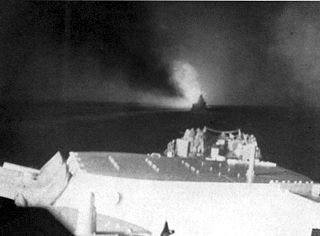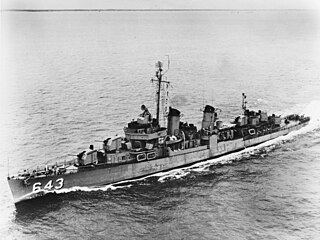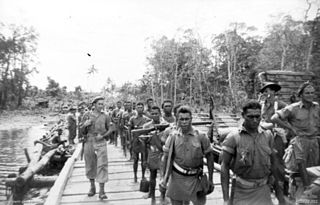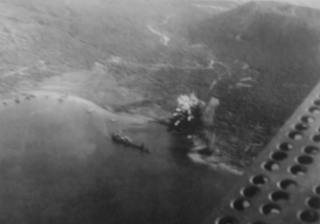External links
Coordinates: 06°14′51″S155°02′24″E / 6.24750°S 155.04000°E
Cape Torokina is a promontory at the north end of Empress Augusta Bay, along the central part of the western coast of Bougainville, in Papua New Guinea.
This cape formed the southern end of the landing zone where the United States I Marine Amphibious Corps performed an amphibious invasion on November 1, 1943 during Operation Cherry Blossom. The small Puruata Island is just off the coast to the west of Cape Torokina. The cape and island form a beach to the north which is subject to heavy surf.
The cape was relatively isolated, with a poor trail system to supply the area. A wide swamp stretched inland from the beach area, and the island was heavily forested. During the landing, the cape was the site of a Japanese 75 mm gun that inflicted heavy damage upon the landing craft.
Following the landing, an airfield was constructed at the cape. Twenty-five miles of roads were also built around the area.
Coordinates: 06°14′51″S155°02′24″E / 6.24750°S 155.04000°E

The Battle of Empress Augusta Bay, on 1–2 November 1943 – also known as the Battle of Gazelle Bay, Operation Cherry Blossom, and in Japanese sources as the Sea Battle off Bougainville Island (ブーゲンビル島沖海戦) – was a naval battle fought near the island of Bougainville in Empress Augusta Bay. The naval battle was a result of Allied landings on nearby Bougainville in the first action in the Bougainville campaign of World War II and may also be considered as part of the Solomons and New Guinea campaigns. The battle was significant as part of a broader Allied strategy—known as Operation Cartwheel—aimed at isolating and surrounding the major Japanese base at Rabaul. The intention was to establish a beachhead on Bougainville, within which an airfield would be built.

USS Montpelier (CL-57) was one of 27 United States Navy Cleveland-class light cruisers completed during or shortly after World War II. She was the second US Navy ship to be named for the city of Montpelier, Vermont. Montpelier was commissioned in September 1942 and saw service in several campaigns in the Pacific. Like almost all her sister ships, she was decommissioned shortly after the end of the war, and never saw active service again. Montpelier was scrapped in the early 1960s.

USS Denver (CL-58) was a Cleveland-class light cruiser. Denver launched on 4 April 1942 by New York Shipbuilding Corp., Camden, New Jersey; sponsored by Miss L. J. Stapleton, daughter of the Mayor of Denver; and commissioned on 15 October 1942, Captain Robert Carney in command. It was the second ship named for the city of Denver, Colorado.

USS McKean (DD-90/APD-5) was a Wickes-class destroyer in the United States Navy during World War II. She was the first ship named in honor of William Wister McKean.

USS Sigourney (DD-643) was a Fletcher-class destroyer, the second ship of the United States Navy to be named for James Sigourney, an officer during the War of 1812.

USS Fullam (DD-474) was a Fletcher-class destroyer in the United States Navy during World War II. Fullam was named for Rear Admiral William Fullam (1855-1926).

USS Wadsworth (DD-516), a Fletcher-class destroyer, was the second ship of the United States Navy to be named for Commodore Alexander S. Wadsworth (1790–1851). The ship was commissioned in 1943 during World War II. After seeing extensive action during the war, the ship was placed in reserve following it. In 1959 the destroyer was loaned to the West German Navy and renamed Zerstörer 3. She remained a part of the West German Navy until 1980 when the destroyer was transferred to the Hellenic Navy and renamed Nearchos. Nearchos was active until 1991 when she was sold for scrap.

The Bougainville campaign was a series of land and naval battles of the Pacific campaign of World War II between Allied forces and the Empire of Japan, named after the island of Bougainville. It was part of Operation Cartwheel, the Allied grand strategy in the South Pacific. The campaign took place in the Northern Solomons in two phases. The first phase, in which American troops landed and held the perimeter around the beachhead at Torokina, lasted from November 1943 through November 1944.

USS Dyson (DD-572) was a Fletcher-class destroyer of the United States Navy. She was named for Rear Admiral Charles W. Dyson (1861–1930).

USS Fuller (AP-14/APA-7) was a Heywood-class attack transport in service with the United States Navy from 1941 to 1946. She was scrapped in 1957.

The Battle of the Treasury Islands was a Second World War battle that took place between 27 October and 12 November 1943 on the Treasury Islands group, part of the Solomon Islands. The battle formed part of the wider Pacific War and involved New Zealand and US forces fighting against Japanese troops. The majority of the ground forces were provided by the New Zealand 3rd Division.

The Raid on Choiseul was a small unit engagement that occurred from October 28 to November 3, 1943, during the Solomon Islands campaign, and was launched to divert Japanese from the Allied landings at Cape Torokina, on Bougainville Island. During the raid, United States Marines from the 2nd Parachute Battalion, landed on Japanese-occupied Choiseul in the northern Solomon Islands and carried out raids on Japanese army and navy forces over a 25-mile (40 km) area over the course of seven days with the assistance of local Choiseul islanders and an Australian coastwatcher. The force was withdrawn back to Vella Lavella by landing craft following the successful lodgment of US troops on Bougainville.

The Landings at Cape Torokina, also known as Operation Cherryblossom, took place at the beginning of the Bougainville campaign in World War II. The amphibious landings were carried out by elements of the United States Marine Corps in November 1943 on Bougainville Island in the South Pacific, as part of Allied efforts to advance towards the main Japanese base around Rabaul under Operation Cartwheel. Coming in the wake of Allied successes at Guadalcanal and in the central Solomons, the landings were intended to secure a beachhead with the purpose of establishing several bases from which to project air and naval power closer towards Rabaul, in an effort to neutralize the large Japanese force that had been established there.

The Battle of the Koromokina Lagoon was fought between the United States Marine Corps and Imperial Japanese Army forces on Bougainville Island. It took place on 7–8 November 1943 during the Bougainville campaign.

The 19th Marine Regiment was a composite engineer regiment of the United States Marine Corps subordinate to the 3rd Marine Division. It existed from September 1942 until September 1944. In December 1943 there was a large change of command in the Regiment. Marine engineer regiments were eventually disbanded in favor of independent engineering battalions within the parent Marine divisions.

USS President Adams (AP-38/APA-19) was a President Jackson-class attack transport of the United States Navy, named for Founding Father John Adams and his son, John Quincy Adams, the second and sixth Presidents of the United States.

The Battle of Ratsua occurred during the Second World War and involved Australian and Japanese forces. Part of the wider Bougainville Campaign of the Pacific theatre, the battle took place in the northern sector of Bougainville between June and August 1945. The main forces that took part in the fighting were the Australian 23rd Brigade and the Japanese 87th Naval Garrison Force.

Rabaul is a town in eastern New Britain, Papua New Guinea. Japanese forces landed on Rabaul on 23 January 1942, capturing it by February 1942. The former Australian territory was transformed into a major Japanese naval and air installation. The Japanese heavily relied on it, using it as a launching point for Japanese reinforcements to New Guinea and Guadalcanal. Throughout the Solomon Islands campaign, neutralizing Rabaul became the primary objective of the Allied effort in the Solomons.

The Bougainville counterattack, also known as the Second Battle of Torokina, was an unsuccessful Japanese offensive against the Allied base at Cape Torokina, on Bougainville Island, during the Pacific Theater of World War II. The Japanese attack began on 8 March 1944 after months of preparation, and was repulsed by United States Army forces in fighting which lasted until 25 March. The attack was hampered by inaccurate intelligence and poor planning and was defeated by the well-prepared Allied defenders, who greatly outnumbered the Japanese force. The Japanese suffered severe casualties, while Allied losses were light.

The Battle for Piva Trail was a battle between United States Marine Corps and Imperial Japanese Army forces on Bougainville Island. The battle took place on 8–9 November 1943 during the Bougainville campaign in the days following the US landing at Cape Torokina earlier in the month.